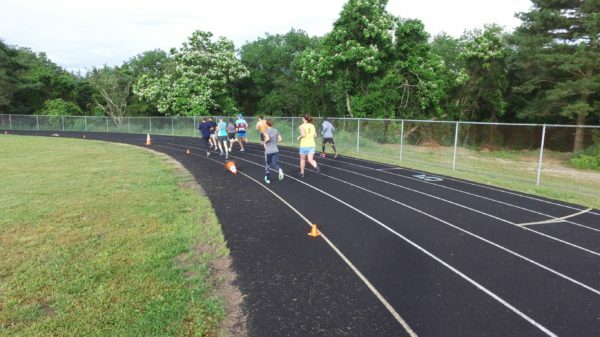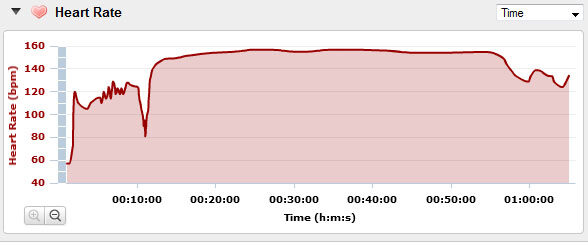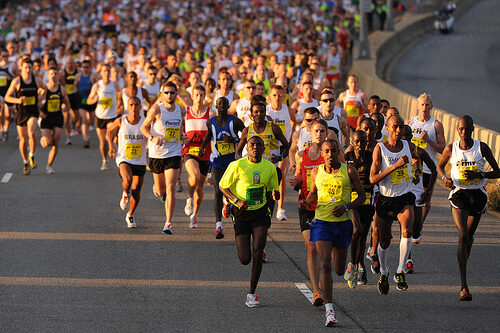When we train for a new distance, we usually ask, “Do you really think I can go that far?” But, as we become accustomed to the increased distance, the question moves very quickly from “how far?” to “how fast?”
In this post, I’d like to focus on two traditional speed training sessions for either cycling or running: 1) tempo efforts and 2) repeats (intervals). Of course, there are other methods that also will enhance an athlete’s speed. For example, in another article, we discussed how hill training is speedwork in disguise.
Tempo Workouts
A tempo session is often described as a “comfortably hard” effort that is designed to improve the way your body metabolizes oxygen, providing energy for your muscles. These sessions can also help with muscular endurance, which is the body’s ability to sustain a powerful effort over a sustained period of time.
But don’t get too “comfortable” with the “comfortably” part of that description. Make no mistake: a tempo effort is challenging. It should be significantly more difficult and faster than your basic aerobic endurance effort, but not as hard as threshold-style intervals or sprints.
It’s “comfortable” only in the sense that you should not be gasping for air. In other words, you are not anaerobic, so much as flirting with the the anaerobic redline (threshold) – but you shouldn’t cross it for extended periods of time; ideally, you want to stay just under or at the line in a very challenging aerobic zone. (See figure below.)
To do a tempo workout, we recommend a good warmup that prepares you for the sustained effort to come. You can include:
- Dynamic stretches
- 10 minutes easy run or spin (run or cycling depending)
- 5-7 x 100 meter (or 20 second-ish) strides with 30 seconds easy for running or 5 x 1 minute builds to hard with 1 minute easy in cycling.
Tempo efforts can start off shorter, such as 3 x 8 minutes with 2 minutes easy. As you progress, you can add time, getting to 20-30 minutes in running, or 40-60 minutes for cycling. In addition to doing one long tempo effort (say 40 minutes), you can also break it up into chunks with a very short recovery period in between. For example, 2 x 20 minute tempo cycling efforts, with 3 minutes of easy spinning, followed by the second 20 minute effort.
Frequency, duration and intensity level is highly dependent upon the athlete’s experience, ability, race distance and other factors we will discuss later in the post.
Interval training
Speed can also be enhanced by repeats, or intervals. Interval training requires you to work at the hardest level of exertion you can sustain for a short period of time. These work intervals are followed by active recovery intervals. For example, you might run 4 x 1 mile repeats with half-mile easy jogs between, or 8 x 400 meters with 400 meter easy walk or jog between.
(Note: some people rest completely in between repeats; we do not advocate that approach for our athletes. Why? Well, that will have to be another post…)
Interval training forces you to work at and beyond the redline – the point at which your body begins to produce energy more from the anaerobic energy system, rather than the aerobic energy system (note: all energy systems are working – it’s just which is privileged more). This shift in energy systems matters because once we shift to using mostly the anaerobic system, our body slows using oxygen to metabolize energy, which some call “oxygen debt”.

Clearly, this situation can’t last forever. Hence, the active recovery period pays back some of the lost oxygen. We notice this “repayment” when we can breathe again and the burning in our legs goes away (at least until the next interval set).The length of the intervals and the amount of rest is based on a variety of factors, which we’ll cover in the next section.Adding these sessions to your training
By adding speed sessions to the training mix in a gradual and building fashion, we teach our bodies to process energy and oxygen more efficiently, which means we can ride or run faster at the same level of exertion. Our bodies adapt to the training stresses and become stronger and faster.
The combination of these types of workouts can lead to measurable progress at race pace. But, they must be implemented safely and gradually into your training plan. Decisions about frequency and duration of speed training need to be carefully considered based on age, experience, history of injury, race goals, and ability.
The distance you are racing also matters for the overall volume of speedwork you introduce into your training plan. For example, an Ironman triathlete will have quite a different approach to speedwork as compared to a sprint triathlete. Similarly, speedwork in training for a 5k will differ from that we might do in preparation for a marathon or an ultramarathon. In these examples, the long-course athlete will need to rely more on oxidative systems (i.e., aerobic) for energy, while the short-course athletes will dip more into their anaerobic system. Therefore, we must train differently in order to prepare for the rigors of racing. The greater volume of time spent training also matters and must be considered part of the training stress.
In general, we don’t recommend more than one speed session per week for running, and no more than two sessions per week for cycling. You need time for recovery. It’s also important to consider the positioning of speed sessions within the training cycle. Speed sessions should be considered as “hard” days and scheduled accordingly. For example, we don’t generally recommend speed sessions the day after (or the day before) a long endurance effort.
Given all of these factors, speed training is far from a one size fits all approach – even for athletes racing the same distance. However, when carefully planned into a training calendar, speed sessions can lead to marked performance gains on race day.


